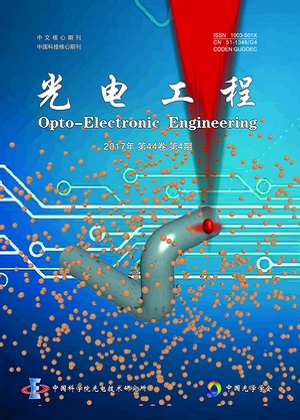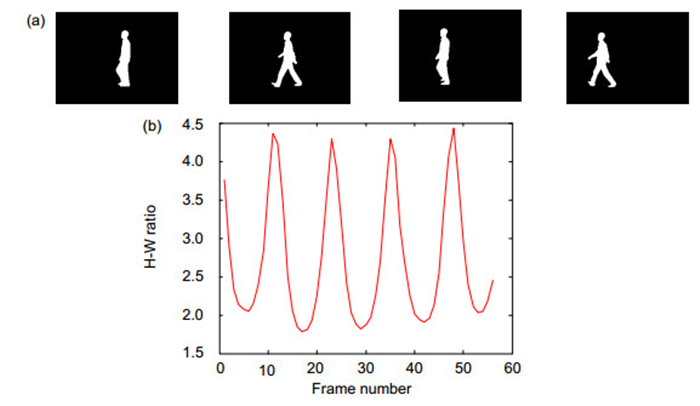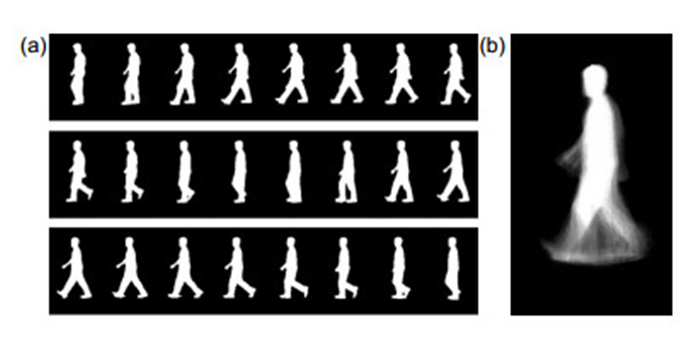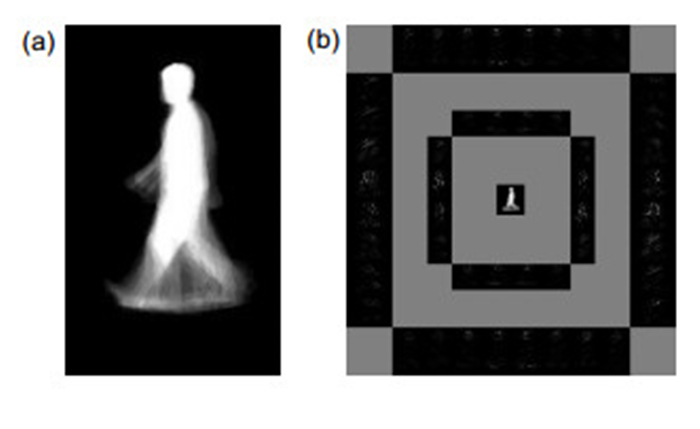| Citation: | Jing Luo, Chunyuan Zi, Jianliang Zhang, et al. Gait recognition using GEI and curvelet[J]. Opto-Electronic Engineering, 2017, 44(4): 400-404. doi: 10.3969/j.issn.1003-501X.2017.04.003 |
Gait recognition using GEI and curvelet
-
Abstract
Gait energy image (GEI) is composed of static body silhouette and dynamic frequency information of human gait. To achieve fast and efficient gait recognition, combined with the accurate description of the information of details and directions in image by Curvelet transform, a gait recognition method using GEI and Curvelet (GEIC) is presented. Firstly, to gain the gait energy images, the gait cycle is selected according to the aspect ratio. Secondly, Curvelet energy coefficients of the GEI, which are used as gait feature vector, are extracted by Curvelet transform in different scales and different directions. Finally, the gait recognition is accomplished by the K nearest neighbor (KNN) classifier. The experimental results demonstrate that GEIC performs well on CASIA(B) database, with the average accuracy of 86.83%. Compared with GEI+KPCA, GEI+W(2D)2PCA and GEI+(2D)2PCA, the algorithm GEIC achieves better robustness in the condition of the person wearing or packaging.
-
Keywords:
- gait recognition /
- GEI /
- curvelet decomposition /
- curvelet feature extraction /
- KNN
-

-
References
[1] Lv Zhuowen, Xing Xianglei, Wang Kejun, et al. Class energy image analysis for video sensor-based gait recognition: a review[J]. Sensors, 2015, 15(1): 932-964. doi: 10.3390/s150100932 [2] Choudhury S D, Tjahjadi T. Silhouette-based gait recognition using Procrustes shape analysis and elliptic Fourier descriptors[J]. Pattern Recognition, 2012, 45(9): 3414-3426. doi: 10.1016/j.patcog.2012.02.032 [3] Luo Jing, Zhang Jianliang, Zi Chunyuan, et al. Gait recognition using GEI and AFDEI[J]. International Journal of Optics, 2015, 2015: 763908. [4] Zeng Wei, Wang Cong. Human gait recognition via deterministic learning[J]. Neural Networks, 2012, 35: 92-102. doi: 10.1016/j.neunet.2012.07.012 [5] Tafazzoli F, Safabakhsh R. Model-based human gait recognition using leg and arm movements[J]. Engineering Applications of Artificial Intelligence, 2010, 23(8): 1237-1246. doi: 10.1016/j.engappai.2010.07.004 [6] Kovač J, Peer P. Human skeleton model based dynamic features for walking speed invariant gait recognition[J]. Mathematical Problems in Engineering, 2014, 2014: 484320. [7] Ben Xianye, Xu Sin, Wang Kejun, et al. Review on pedestrian gait feature expression and recognition[J]. Pattern Recognition and Artificial Intelligence, 2012, 25(1): 71-81.(in Chinese) [8] Zeng Wei, Wang Cong, Yang Feifei. Silhouette-based gait recognition via deterministic learning[J]. Pattern Recognition, 2014, 47(11): 3568-3584. doi: 10.1016/j.patcog.2014.04.014 [9] Lee C P, Tan A W C, Tan S C. Time-sliced averaged motion history image for gait recognition[J]. Journal of Visual Communication and Image Representation, 2014, 25(5): 822-826. doi: 10.1016/j.jvcir.2014.01.012 [10] Man J, Bhanu B. Individual recognition using gait energy image[J]. IEEE Transactions on Pattern Analysis and Machine Intelligence, 2006, 28(2): 316-322. doi: 10.1109/TPAMI.2006.38 [11] Sharma P, Yadav R N, Arya K V. Pose-invariant face recognition using curvelet neural network[J]. IET Biometrics, 2014, 3(3): 128-138. doi: 10.1049/iet-bmt.2013.0019 [12] Elaiwat S, Bennamoun M, Boussaid F, et al. A curvelet-based approach for textured 3D face recognition[J]. Pattern Recognition, 2015, 48(4): 1235-1246. doi: 10.1016/j.patcog.2014.10.013 [13] Song Dan, Luo Jing, Zi Chunyuan, et al. 3D face recognition using anthropometric and curvelet features fusion[J]. Journal of Sensors, 2016, 2016: 6859364. [14] Li Linfu, Zhang Xiangchao, Zhang Hao, et al. Feature extraction of non-stochastic surfaces using curvelets[J]. Precision Engineering, 2015, 39: 212-219. doi: 10.1016/j.precisioneng.2014.09.003 [15] Luo Jing, Song Dan, Xiu Chunbo, et al. Fingerprint classification combining curvelet transform and gray-level cooccurrence matrix[J]. Mathematical Problems in Engineering, 2014, 2014: 592928. [16] Liang Shaocong, Zhou Ming, Li An'an, et al. GEI based gait recognition by using KPCA and SVM[J]. Application Research of Computers, 2010, 27(7): 2798-2800. (in Chinese) [17] Wang Kejun, Liu Lili, Ben Xianye, et al. Gait recognition based on gait energy image and two dimensional principal component analysis[J]. Journal of Image and Graphics, 2009, 14(12): 2503-2509. (in Chinese) -
Overview

Abstract:International and domestic academics are attracted by biometric features recognition, because the intelligent monitoring, which is the basis of social security, is more and more required by people. Compared with other biometric features (face, iris fingerprint and so on), gait feature has its advantages, such as acceptability, noninvasiveness, hard to hide and easy to be collected. Gait recognition, recognizing different persons by the way of his/her walking, which has some advantages such as non-contact, low demand in image quality and difficult disguise, is the most potentially biological recognition technology by the way of one’s walking. Recently, the research of gait recognition is a hot topic in the field of computer vision, entrance guard system and medical diagnose, which has extensive realistic significance and wide applying foreground.
Gait feature, which is extracted to describe the motion of a cycle gait, is the key step of gait recognition to our way of thinking. Gait energy image (GEI), which contains both the static silhouette feature and the dynamic frequency of each part of human body in the process of walking, is demonstrated to be an effective feature for identity recognition. GEI reflecting gait characteristic is gained from gait images of one cycle by using weighted average method. Compared with using all the gait images of one cycle as the gait feature, computation complexity is decreased in a large part by using GEI. Curvelet transformation is a multi-scale pyramid decomposition, which reflects one image at different directions and scales. However, this pyramid is nonstandard because the length and width which is the square of length in each Curvelet are variable. On account of the accurate description of the detail and direction information of gait frequency by Curvelet transform, GEI is analyzed in the view of texture analysis by the extracted Curvelet features.
To achieve fast and efficient gait recognition, combined with the accurate description of the information of details and directions in image by Curvelet transform, a gait recognition method using GEI and Curvelet (GEIC) is presented. Firstly, the gait cycle is selected through analyzing the aspect ratio of a gait sequence and one cycle gait images are normalized and centralized to reduce redundant information computation complexity. Secondly, gait energy image is extracted by weighted average method from those gait images after preprocessing. Thirdly, Curvelet energy coefficients of the GEI, which were used as gait feature vector, were extracted by Curvelet transform in different scales and different directions. Finally, the gait recognition was accomplished by the K nearest neighbor (KNN) classifier. The experimental results demonstrate that GEIC performs well on CASIA (B) database, with the average accuracy as 86.83%. Compared with GEI+KPCA, GEI+W(2D)2PCA and GEI+(2D)2PCA , the proposed algorithm based on GEI and Curvelet for gait recognition gets higher performance. Thus, the information of human body silhouette and motion frequency in GEI can be expressed accurately by Curvelet with less energy coefficients in the multi-scale, considering the view of the edge and texture. Using the energy coefficients of Curvelet transform as gait feature vector can not only improve the recognition efficiency, but also reduce the dimension of gait feature which basically satisfies the real-time requirement.
-
Access History

-
Figure 1.
GEIC algorithm flow chart.
-
Figure 2.
(a) Four cases of reaching extreme point in one gait cycle. (b) The H-W ratio curve of a gait sequence.
-
Figure 3.
Gait silhouette normalizing.
-
Figure 4.
(a) A cycle of Gait sequence images. (b) The corresponding GEI.
-
Figure 5.
(a) GEI. (b) The responding Curvelet decomposition.

 E-mail Alert
E-mail Alert RSS
RSS



 DownLoad:
DownLoad:






